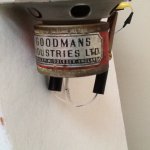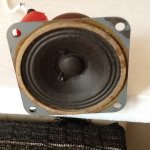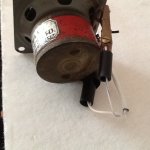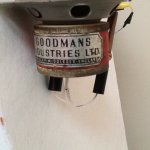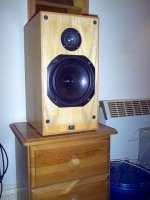Would like to help but the image shack link is just plain wrong and the images you've posted prior are way too small. C'mon Rockaway you can do it! Post your images here on diyAudio...ain't hard.
Last edited:
Well, this is embarrassing. I can't find any way to upload images without using (crappy)image hosting. Is this because I haven't donated sufficient funds to earn the priveledge?
Hi,
Unusual that it is not sealed back.
Alnico ring magnet.
Probably will go low for a 2" tweeter.
Probably intended for openbacked cabinets.
Probably with a big main driver.
rgds, sreten.
Unusual that it is not sealed back.
Alnico ring magnet.
Probably will go low for a 2" tweeter.
Probably intended for openbacked cabinets.
Probably with a big main driver.
rgds, sreten.
Really remarkable clarity. Keeps up with some AMT Heil Tweeters so I imagine quite efficient as well. Sreten, you hit the nail on the head regarding the open back. I see many with closed backs but none like this.
I'm a great fan of cone tweeters. They strangely resemble 2-3" radio speakers, of course. Built the same, I expect. I use this closed back Monacor HT22-8. Monacor also do a polycone tweeter, the SPP-90 which I must try.
Attachments
Last edited:
Not to impose some puritanical ethic on the subject, but paper cones seem to project what I can only describe as an "honest sound". Other types are good in their own way but I feel as though I am being seduced somehow. That's not always a bad thing.
Hey Rockaway.....kind of a 2" Goodman's variant of the Wharfedale Super 3 at first blush. I have one like this lying somewhere about, but with a grey colored basket. I'll see if I can find it.
I agree with Sreten that they were likely out of something open-backed or installed in a small sealed chamber ala Wharfedale W-60, 70, 90 etc.
Yes there's something about a good paper cone tweeter that just seems right....System7 seems to like them too.
Somewhere in early 70s the move to domes by so many manufacturers seems to have made the poor cone tweeter fall completely out of fashion. But given the ridiculous prices of new dome tweeters of any real quality I'm predisposed to utilizing my stock of Peerless, JBL, Phenolic ring cone tweeters and the like.
I tend to agree with others like System 7 that domes have a number of real nasty characteristics that simply don't agree with my ears and definitely not with my budget.
There have been a few others here who've touted the Matsushita 2" cone tweeters as the cat's meow if one can find them.
So the question is: what are you going to do with these little Goodmans' beauties?
I agree with Sreten that they were likely out of something open-backed or installed in a small sealed chamber ala Wharfedale W-60, 70, 90 etc.
Yes there's something about a good paper cone tweeter that just seems right....System7 seems to like them too.
Somewhere in early 70s the move to domes by so many manufacturers seems to have made the poor cone tweeter fall completely out of fashion. But given the ridiculous prices of new dome tweeters of any real quality I'm predisposed to utilizing my stock of Peerless, JBL, Phenolic ring cone tweeters and the like.
I tend to agree with others like System 7 that domes have a number of real nasty characteristics that simply don't agree with my ears and definitely not with my budget.
There have been a few others here who've touted the Matsushita 2" cone tweeters as the cat's meow if one can find them.
So the question is: what are you going to do with these little Goodmans' beauties?
Soft domes sing their own tunes. The centre of a soft dome is just not tightly coupled to the voicecoil. Hence it spits and sizzles at the centre. Ruins the signal to noise ratio, although the flat frequency response won't reveal that.
Probably better is the ring radiator idea, like the Vifa XT25 or SS R2604 or some SB acoustics devices. These pin the centre still.
Metal domes work better too. They are high resolution.
And a cone works well at all frequencies. Ideally with a bit of material damping, the radiating area decreases with higher frequency. Since dustcaps are always troublesome, a lot of good cone tweeters used a metal one. I find them very musical.
Audio Physic are still putting effort into cone tweeters:
[audio physic] - no loss of fine detail
Probably better is the ring radiator idea, like the Vifa XT25 or SS R2604 or some SB acoustics devices. These pin the centre still.
Metal domes work better too. They are high resolution.
And a cone works well at all frequencies. Ideally with a bit of material damping, the radiating area decreases with higher frequency. Since dustcaps are always troublesome, a lot of good cone tweeters used a metal one. I find them very musical.
Audio Physic are still putting effort into cone tweeters:
[audio physic] - no loss of fine detail
Something tells me those Audio Physics variants aren't going to be inexpensive.
When you say "dustcaps are always troublesome" what specifically are you referring to regarding the cone tweeters Steve?
In the case of the Wharfedale Super 3's only one version was made with a metal dustcap and that was specifically for the SFB/3 as a means to extend the freq response a couple of khz.
As to metal domes I've always found them far too bright without padding them down.
Anyways surprised no one from your side of the pond can give Rockway some insight into these particular Goodmans Tweets.
When you say "dustcaps are always troublesome" what specifically are you referring to regarding the cone tweeters Steve?
In the case of the Wharfedale Super 3's only one version was made with a metal dustcap and that was specifically for the SFB/3 as a means to extend the freq response a couple of khz.
As to metal domes I've always found them far too bright without padding them down.
Anyways surprised no one from your side of the pond can give Rockway some insight into these particular Goodmans Tweets.
Metal domes need a Zobel IMO. 7.5R plus 0.68uF to tame the top end? Otherwise fatiguing.
A soft dome or paper dustcap in general behaves badly. It rings and breaks up. You can do the math. The peanut gallery here isn't interested. They just go by frequency response.
I think most of the famously good cone tweeters used a metal dustcap. After all, a 1/2" metal dustcap ought to go nearly supersonic.
HT-22/8
The paper dustcap Visaton TW70, with the on-axis 15kHx peak, doesn't sound nearly as good to me:
TW 70 - 8 Ohm
I've probably heard these Goodmans cone tweeters. They were fairly standard back in the day (sixties), matched to a 8 or 10" Goodmans bass on valve amplification with a truly simple crossover. AlNiCo magnets, which are supposedly smoother sounding. All sounded very nice, IMO. You could actually fool yourself that the artists on LP were in the room, but then we used moving coil Decca FFSS cartridges too. 😎
A soft dome or paper dustcap in general behaves badly. It rings and breaks up. You can do the math. The peanut gallery here isn't interested. They just go by frequency response.
I think most of the famously good cone tweeters used a metal dustcap. After all, a 1/2" metal dustcap ought to go nearly supersonic.
HT-22/8
The paper dustcap Visaton TW70, with the on-axis 15kHx peak, doesn't sound nearly as good to me:
TW 70 - 8 Ohm
I've probably heard these Goodmans cone tweeters. They were fairly standard back in the day (sixties), matched to a 8 or 10" Goodmans bass on valve amplification with a truly simple crossover. AlNiCo magnets, which are supposedly smoother sounding. All sounded very nice, IMO. You could actually fool yourself that the artists on LP were in the room, but then we used moving coil Decca FFSS cartridges too. 😎
Last edited:
You may recall that I have worked my way through several variations of the Super3. Ceramic with paper dust cap, and two versions of the metal cap variety. One early 60s version restored by the person whose site can be found here: WHARFEDALE (I highly recommend this site. Robert is a very knowledgable and generous person. I have learned a tremendous amount from him)
and lastly,one unrestored from 1957. The latter is the best to my ears so far for reasons I cannot define. Measurements would reveal some aspects of this but I don't have any. These Goodmans might have an edge on the Super3 which is shocking. I subscribe to the flawed philosophy that bigger and heavier is always better where speakers are concerned. The Yamaha JA6681b tweeters being the heaviest I have heard, and reputed to being on par with Tad drivers are harsh compared to the Goodmans and outweigh them by more than 10 lbs. my guess is that the cone on the Goodmans is lighter than the Wharfedale and overall the driver is more sensitive and does not need to be driven as hard therefore less distortion. I am finishing off my open baffles and keep circulating different tweeters ( the Goodmans and ESS HEIL) being the last in a long line of contenders. The Goodmans front firing with a small waveguide, might win out.
and lastly,one unrestored from 1957. The latter is the best to my ears so far for reasons I cannot define. Measurements would reveal some aspects of this but I don't have any. These Goodmans might have an edge on the Super3 which is shocking. I subscribe to the flawed philosophy that bigger and heavier is always better where speakers are concerned. The Yamaha JA6681b tweeters being the heaviest I have heard, and reputed to being on par with Tad drivers are harsh compared to the Goodmans and outweigh them by more than 10 lbs. my guess is that the cone on the Goodmans is lighter than the Wharfedale and overall the driver is more sensitive and does not need to be driven as hard therefore less distortion. I am finishing off my open baffles and keep circulating different tweeters ( the Goodmans and ESS HEIL) being the last in a long line of contenders. The Goodmans front firing with a small waveguide, might win out.
Goodmans manufactured speakers for the radio and T.V. consumer market as well as the specialist Hi Fi trade.I suspect that the speaker shown could be from a radio set and by the appearance of the magnet it is likely that it dates from the late 1940,s onwards.
Thanks Barry. I was hoping you would jump in on this thread. This came to me from Canada. Curious if Canada had different suppliers and products with regard to Goodmans Wharfedale,Tannoy and the like compared to the U.S. given it's (Canada's) cozier relationship with the UK. I have yet to see these in the decade or so that I have been combing eBay for Goodmans speakers. That may merely be due to their age however.
- Status
- Not open for further replies.
- Home
- Loudspeakers
- Multi-Way
- 1950's Goodmans Tweeter Info Please.
